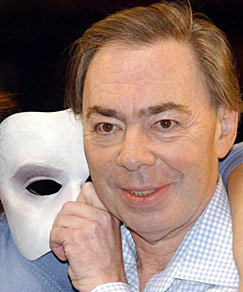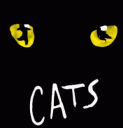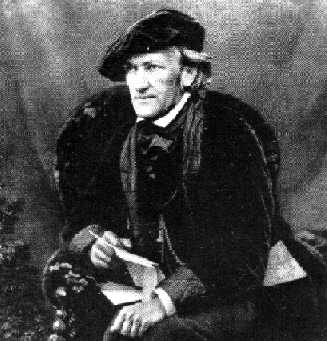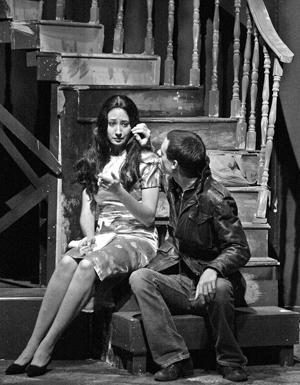
Lord Andrew Lloyd Webber is probably one of the most vastly influential members of today’s Musical Theatre community. There is hardly a soul with any knowledge of Musical Theatre that does not have knowledge of one or more of his immensely popular musicals. Each of his plays deploys more than one different musical style, and each and every one of them uses a different combination of dance, song and theatre itself. Some of his plays can be described as rock operas, that use no speech at all, only song, such as Joseph and the Amazing Technicolour Dreamcoat, while some musicals, such as Phantom of the Opera, use speech to further the storyline. Even so, it can’t be said that, in their own way, each musical brings about powerful reactions from the audience and listener alike. For the purposes of this essay, we will use demonstrations from his earlier works, previous to the 1990’s.
Lord Webber was born in London, England, on March 22nd, 1948. From a young age on, the young man had a taste for music, and started composing his own little projects by the time he was nine years old. Studying music all through his life, he was first introduced to musicals by his aunt, and he became instantly addicted. Upon graduating, he went to Oxford to study music. There he met a young man named Tim Rice, a lyricist. The two struck up a friendship and Lord Webber soon dropped out of Oxford in favour of writing musicals. While their first musical, The Likes of Us, written in 1965, was met with distaste, and was not professionally performed until 2005, it did not stop the two aspiring musical artists.
The first success of their efforts was the musical Joseph and the Amazing Technicolour Dreamcoat, written in 1968. While not huge, it became their first hit, and would later gain fame in the 1992 movie of the same name staring Donny Osmond. This musical, his first great success, was written when Lord Webber was only nineteen years old. After Joseph came Jesus Christ Superstar, written in 1970. This would, like Joseph, start off as acclaimed, but gain more fame as their careers progressed. It was during their next production, Jeeves, that the two parted ways for the first time. The musical, based on the novels “Jeeves and Wooster” by P. G. Wodehouse, was a favourite of the two musical writers, and Tim Rice did not believe that he would be able to write justice to the great writer. Thus, Lord Webber teamed with lyricist Alan Ayckbourn to finish the production. While it flopped in its original release in 1975, it was released again, revised, in 1996 as By Jeeves to much more success.
Within the next ten years, Lord Webber wrote what had to be his best and most successful works, the ones that made him known by his very initials throughout the musical-following crowd. The first, written in 1976, was Evita, based on the life of Eva Peron. This marks the last, to date, production that he has done with friend Tim Rice. The show was highly received and was turned into a musical starring Madonna in 1996. His next large show, and probably his second most well-known, is the musical Cats. Up until 2006, it remained the longest running show on Broadway, but was beaten out by another of his own musicals.
The next musical on Lord Webber’s list was a musical that while received well in his native London’s West Side, ran for less than three years in America. This was the Starlight Express, which is one of his less-known works of art created in 1984. It is still recognized by any and all Andrew Lloyd Webber enthusiasts, and some of its songs are included in most anthologies gathered to honour the composer’s work. While not a musical, there was also a combination show, of sorts, entitled Song and Dance, which was written in 1982. It was one part song and one part dance, originally created separate of each other, but were incorporated into one to tell a love story.
In 1986, ten years after Evita, Lord Webber wrote the musical that, to this day, has made him one of the most famous composers in the world. The musical is Phantom of the Opera, and was the musical that beat Cats out for the longest running musical on Broadway. To this day, it is still one of the more well-received in musical theatre. The musical combines elements of opera and pop, with rock and roll to create a fairly unique form of music in his genre, in its time. Perhaps thanks to this, it tends to be known throughout the world at the very mention of its name. In some ways more spectacular than the music itself were the amazing special effects used within the production. It is universally known for its chandelier hurtling towards the audience, and its spectacular costumes. The play combined a wide range of dancing and theatre techniques, including ballet and masquerade.
With all of his massive accomplishments, and the adaptations of all his plays, even with the most famous of them being older than twenty, all of them are still known throughout today’s society. The artistic values behind some of his productions were amazingly high and some of them were so high that they lost money; one of them lost twenty five million dollars due to its production costs, though it was a large hit. Even having this black mark, it was one failure on a list of musicals that made millions and millions. Within today’s artistic society, Lord Webber’s name is associated with some of the most well-known, longest running modern musicals. The way his musicals vary in difficulty also makes them adaptable for both professionals and high schools alike. In fact, it is very unlikely that at least one person in twenty will not know someone who was in an Andrew Lloyd Webber musical, most likely Joseph or the children’s adaption of the play.
While in the past twenty years, he has not done anything overly spectacular, the plays from his decade of glory have remained on and off Broadway, or in London, as long as they’ve been in production. In fact, Phantom still plays every night at the Queen Elizabeth Theatre in London, and has since its very release. When any of his shows come to town, it’s rare that they’re not totally sold out. People want to see the legend in action. His plays have become so famous that they now require revivals just to keep with the demand. Even so, due to their production costs, they are quite the musical-theatre delicacy anywhere they show.
Information Gathered From:
http://hem.passagen.se/musicals/andrew.html
http://en.wikipedia.org/wiki/Andrew_Lloyd_Webber
![]()














You must be logged in to post a comment.